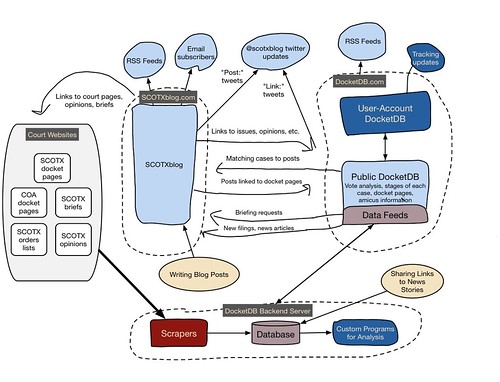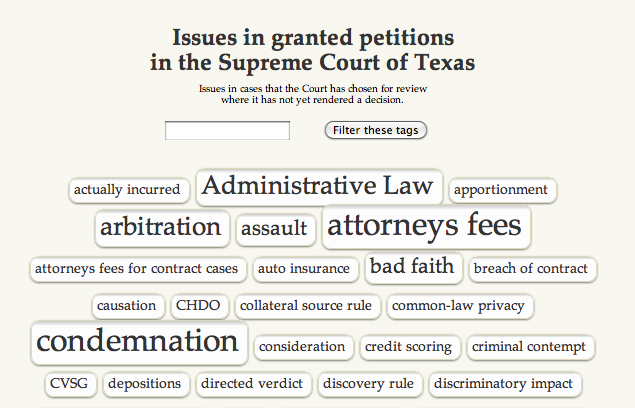Category: 'DocketDB'
July 9th, 2012 · Comments Off on Some upcoming construction on the blog (and an update on DocketDB)
SCOTXblog will be undergoing some major construction this summer.
The timing is driven by the imminent launch of TAMES in the Texas Supreme Court. The Houston courts have already launched the system, and so I have a better sense of how these changes will affect the websites that I’ve built to follow the Court.
As you’d expect, I will be watching the TAMES rollout as closely as anyone. It will include many of the features I built for DocketDB — along with some others that no one outside of the courts themselves could have implemented (like copies of motions and letters).
They call the internet a “web” for a reason
Here’s a rough sketch of how my Texas court-watching projects fit together:

On this chart, the blog you’re reading is near the middle. My personal court-tracking database is at the bottom, and you can see how some of those connections flow through to public sites (like the blog or the public areas of DocketDB).
As crazy as this chart looks, it seems to work. Some of the scrapers have been running for more than five years with very little modification.
The future of DocketDB and SCOTXblog
While TAMES is a great deal for the public, it has a cost for me. My private court-tracking system is built on a foundation of “scrapers”, tuned to understand the old website. When the new site goes live, the Court’s docket information will be shifted to new pages and put in new formats. The existing scrapers will not know how to find or work with this information, so data will stop flowing into my private database, which in turn will freeze the public version of DocketDB. (( This has happened on a smaller scale at various times this spring, as the Court has made small improvements to its website. Even tiny changes on the Texas Supreme Court website — such as putting the description for a particular kind of docket-sheet entry into plainer language — confuses the scrapers. I’ve been able to make small fixes as these have come to my attention. The TAMES rollout will be an order of magnitude (or two) more complex. ))
For that reason, I anticipate that the public version of DocketDB (including registered accounts) will also wind down soon after the Court switches over to TAMES. That site needs a consistent flow of accurate data, and I won’t have that until I build a new set of scrapers for my own tracking system.
My first priority is fixing SCOTXblog. The easiest approach would be to cut the connections between the blog and my court-tracking software, leaving just a basic blog in place. But that’s not my style.
I’d much rather build a new platform for SCOTXblog that can better support the kind of case updates and articles that I’d like to write — and that, I hope, you’ll want to read.
I’ll update you as I make progress. In the meantime, you may see some longtime blog features start to disappear or stop working (like the feed of news articles or briefing requests). If you see something that looks more broken than usual, please let me know. And, of course, please stay tuned. I look forward to sharing the new site once it’s ready.
Tags: DocketDB · SCOTXblog Announcements
December 1st, 2011 · 1 Comment
This seems as good a day as any to talk about the Justices’ output last Term.
We know how many signed opinions each Justice wrote as soon as they’re published. But the per curiam opinions are a mystery. It’s not until the Texas Office of Court Administration (OCA) releases its year-end report that we get a count of how many were credited to each Justice.
Now that OCA has released its report, I’ve updated my chart of opinion authors, which shows:
- Justice Hecht led the way with 27 deciding opinions — 15 signed and 12 per curiams.
-
Justice Johnson (19 deciding opinions) and Justice Wainwright (16 deciding opinions) also exceeded the Court’s average of slightly more than 12 per Justice. (Justice Medina and Chief Justice Jefferson were very close to that mark.)
-
The most frequent author of concurring opinions was Justice Willett with 7, almost half the Court’s output of 16 concurrences. Chief Justice Jefferson was a strong second with 4 concurrences.
-
The most frequent author of dissenting opinions was Justice Johnson with 6, closely followed by Justice Lehrmann with 5. Justice Wainwright also had 5, if you fold in opinions that were both “concurring and dissenting.” Every Justice authored at least one true dissenting opinion.
-
No Justice wrote more per curiams than signed majority opinions. Only Justice Hecht authored more per curiams than separate (concurring or dissenting) opinions. The focus was very much on clearing out the signed opinions from the Court’s docket.
These OCA statistics focus on opinion authorship — the traditional (albeit imperfect) measure of output for appellate judges.
We might soon have some new measures, thanks to recent legislative demands for details about how individual Justices have been meeting the Court’s internal deadlines. And as it turns out, those reports are due on December 1st of each year. (( You can find the language on page 3 of this very large PDF, part of the appropriations bill in 2009. ))
Tags: DocketDB · Practice Notes
May 10th, 2011 · Comments Off on Some new DocketDB features you should know about
I’ve been rolling out a steady stream of updates to the DocketDB site. I shared some of these at the recent Practicing Before the Supreme Court of Texas CLE. Since that time, I’ve added a new way to present the Court’s opinions.
Front-page search
The DocketDB home page now has a search box in the top right. Just start typing part of the name of a pending or recent case — and autocomplete will find the docket number for you.
It’s a small feature, but even I am finding it much easier to use DocketDB as the first stop in looking up a pending case. Once there, you can quickly find the slip opinions, the relevant court of appeals information, briefs from the case, or the most recent events.
Issues/Granted
A persistent question is how to track what issues are pending. This is a project that all court-watchers do in our own ways. But I realized that the DocketDB engine would be a good platform for a community effort.
If you go to http://docketdb.com/issues/granted, you’ll see the early results. This collects keyword tags about the pending cases in which the Court has granted review. (It’s focused on the granted petitions and those that have been submitted after oral argument.) Click on a tag, and you’ll be taken to a list of the relevant cases, with the usual links to news articles, briefs, and the most current status of the case.
My hesitation in rolling out this feature is that I don’t want to create a job for myself. (( Well, I didn’t want to create another job for myself. )) So, as I said at the Practicing Before the Supreme Court seminar, I’m approaching this “Issues/Granted” page as a community feature. I am happy to supply the platform and to keep the underlying data about each case fresh.
But the keywords require a human touch. Anyone registered with DocketDB can help tend this garden by adding relevant tags, and I hope you will participate. If enough of you pitch in just a little time, we all benefit. (( If you have questions about how this keyword system works, feel free to email me or give me a call. ))
To help everyone stay on the same page, there is now an autocomplete feature when you enter a tag — just start typing a new tag, and you’ll see what related keywords are already in the database.
An integrated version of the Court’s opinions
As you know, the Court publishes its opinions both as raw HTML files and as PDF slip opinions. In the past, I have linked to the HTML version on the Court’s website, which redirected your browser to that page.
Starting this week, DocketDB is now republishing these opinions. Here’s an example or two. And here’s why:
- Readability: The Court’s HTML version is generated by a word processor, and the result is text that wraps edge-to-edge on the screen. It’s often frustrating to read; I find myself re-sizing the browser window nearly every time. I opted to have a single-column of text that’s a more readable width.
-
Related opinions: My version collects all opinions from the same case along the sidebar — so you can quickly access a concurrence or dissent.
-
Faces: Everybody likes faces.
-
Warnings for withdrawn or at-risk opinions: My version gives you a warning if an opinion has been withdrawn (or rehearing has been granted). It gives you a gentler warning if a rehearing motion is still pending. These notices are kept up-to-date by the DocketDB database.
-
Link to the PDF: If you want to download the PDF version, there’s a direct link from the HTML page. You no longer have to backtrack to find it.
-
Quicker access to other DocketDB resources: You are now just a click away from links to related news stories, the underlying court of appeals information, or a list of the electronic briefs.
Those are the initial benefits. I’m also excited about the other, more advanced features that this should make possible. Your input is appreciated and, as always, you’ll be the first to know.
Tags: DocketDB · Legal Tech · Practice Notes




